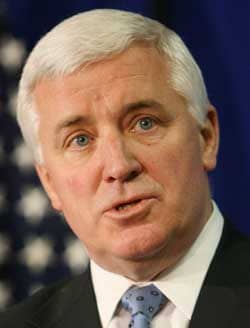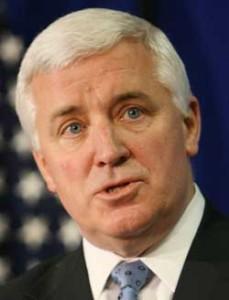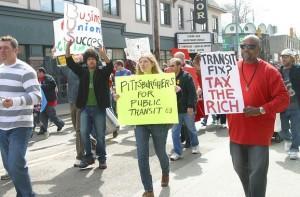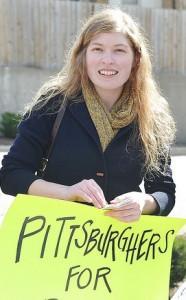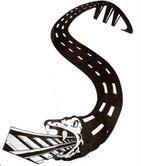 Tom Wetzel is a member of Workers Solidarity Alliance, posted on http://nefac.net/CaliTransit
Tom Wetzel is a member of Workers Solidarity Alliance, posted on http://nefac.net/CaliTransit
For the older big cities in North America, public transit is critical to their daily functioning. Organizing among workers and riders on public transit has a strategic importance.
Buses, light rail cars and subway trains attract a diverse working class ridership. Workers in small factories, department stores, hospitals, and restaurants are thrown together on the bus. We encounter retirees going to a doctor’s appointment, the unemployed, working class students going to classes at a community college, people of all colors and nationalities, immigrants and native-born. Organizing among transit riders allows the organizers to interact with a broad spectrum of the working class population.
Transportation is how people glue together the various fragments of their lives spent in different locations. If transit workers were to strike, it could bring a large city to a halt. This gives the large workforce of a transit system a strategic position in the local economy.
Public transit subsidies were a major gain achieved by the working class in the ’60s/’70s era. This became a component of the “social wage” — benefits working people receive through government programs.
Throughout the first half of the 20th century, public transit was a capitalist industry. Even when government agencies took over transit systems, they still operated them like a business. For example, the fares paid by riders on the bus system in Los Angeles paid all of the operating costs as recently as 1970. Today, the proportion of expenses paid by fares varies from a high of 42 percent in New York City, to 26 percent in Los Angeles, and only 12 percent in San Jose.(1)
The present Great Recession has greatly ramped up the fiscal crisis of the state which has been developing in the USA since the late ’70s. The result has been increasing attacks on the public transit component of the social wage, through service cuts and fare hikes.
Cost-shifting, the Ecological Crisis and the Automobile
One of the most important ways that capitalist firms generate profit is through cost-shifting. When firms intensify the pace of work or expose workers to dangerous chemicals, they are shifting costs of production onto workers. When costs are shifted onto others, it lowers the firm’s expenses.
Workers are on the front line of pollution. When factories spew toxins in the air, factory workers are the first to be exposed to danger. As Murray Bookchin emphasized, the ecological crisis is rooted in relations of social domination. Costs are shifted onto vulnerable or dominated populations…farmworkers are poisoned by pesticides, residents of communities of color near refineries or waste facilities are polluted, extractive firms push aside indigenous communities to seize forest or mineral resources, or rural people are subjected to the toxic pollution from oil and gas wells. Because these cost-shifting practices are rooted in domination, they are forms of environmental injustice.
Automotive technology has been exploited by capitalist firms to facilitate a wide variety of cost-shifting behaviors.
First there was Henry Ford’s re-organization of auto production in his Highland Park factory between 1910 and 1917. Through machine-pacing, systemic de-skilling of jobs, a relentless work pace, soul-crushing discipline, and employment of stool pigeons to crush unions, Ford was able to reduce the price of his Model-T from $825-850 in 1908 to a low of $270 in the mid-’20s. Other auto manufacturers were forced to adopt the same work organization in order to compete. Mass ownership of cars in the USA would not have been possible without this price reduction.
Mass car ownership was seized upon by the real estate development industry for their own forms of cost-shifting.
Prior to the 1920s, real estate investment in urban centers was tightly linked to investment in streetcar lines. Much of the capital for transit was provided as subsidies from real estate developers. This also created the characteristic American “downtown.” Typically developers financed streetcar lines out to subdivisions from the center where the jobs and services were located. This made land at the center of the transit system very valuable. The high value of the real estate tended to drive out less valuable residential or industrial uses. Downtowns became wall-to-wall areas of commercial development.
Beginning in the mid-’20s, real estate developers were able to rely on auto ownership by middle class homebuyers. Vehicle costs were shifted to motorists. Roads were paid for through user and property taxes.
Once a large part of the population owned cars, this led to changes in the pattern of investment in retail centers. The shift began in the ’30s with grocery stores. In the ’20s a typical store was about 5,000 square feet and didn’t have offstreet parking. People walked to the store frequently, and usually bought only small amounts. By the ’30s the big grocery chains in Los Angeles and some other cities hit upon the idea of volume selling by attracting people in their cars. They could take more groceries home with them, and the new electric fridges allowed them to store more food for a longer period of time. Stores could attract more customers from a larger area with free parking. Stores got larger. By 1940 stores in Los Angeles were typically 20,000 square feet.
After World War 2, this pattern of using large amounts of free parking to attract people from a very wide area became the basis for investment in regional malls and local mini-malls. Developers of retail centers were using free parking as a competitive wedge to defeat old-fashioned sidewalk-oriented retail. Suburban “business parks” also were built to compete with the office centers in the older downtowns.
Of course, these auto-oriented patterns were much more thoroughly implemented in the newer suburban rings built up in the decades after World War 2.
These changes have had a major effect on public transit use. Public transit use is much lower today in all cities than it was in the ’40s. But remaining ridership tends to be highest in older big cities built up during the streetcar era. In the USA as a whole, about 60 percent of the working poor have cars. In older central cities, however, a majority of the driving-age population in working class neighborhoods typically do not own a car.
The pattern of land-use tends to favor walking and transit use. Many of the jobs are downtown. In neighborhoods there are often stores within walking distance…a bodega or cafe at the corner and various other services nearby. This pattern makes it easier to live without owning a car.
We can see how land-use affects transit use if we compare transit usage in urban areas. New York City and San Francisco are at the top of the pack. In both cities the transit system provides roughly 270 annual rides per resident. The second tier of transit cities deliver between 130 and 170 annual public transit rides per resident. This includes Boston, Philadelphia, Chicago and central Los Angeles.
The third tier is made up of more auto-centric suburban areas or cities that grew up mainly after World War 2. This includes Silicon Valley, the East Bay, San Fernando Valley, and the northern New Jersey suburbs of New York City. In these areas public transit use is about 40 to 50 annual transit rides per resident.
A more dispersed, auto-oriented land-use pattern makes public transit ineffective. This means it is also more expensive to provide transit service in auto-oriented suburban areas. For example, in Los Angeles a transit ride in the San Fernando Valley costs the Los Angeles MTA 43 percent more than a transit ride in central Los Angeles. Also, a dispersed, low-density pattern increases costs for the utility grids. These higher costs are additional examples of cost-shifting by capitalist developers.
Of course, the shift to mass auto ownership in the USA since World War 2 also brought environmental cost shifting such as air and noise pollution.
The USA generates about one-fourth of the world’s air pollution and greenhouse gas emissions though it has less than five percent of the world’s population. Residents of American urban areas consume:
- Nearly twice as much gasoline per person as residents of Australian cities.
- Nearly four times as much gasoline per person as residents of European cities.
- Ten times as much gasoline per person as a number of Asian cities such as Hong Kong, Singapore and Tokyo.
This auto-dependency is rooted in both the physical layout of American urban areas and decades of disinvestment in public transit.
Los Angeles Transit Before the Bus Riders Union
With no taxpayer support, public transit in Los Angeles had deteriorated continuously from the ’20s on. Lack of rapid transit access meant that downtown Los Angeles was at a disadvantage in competing with new outlying centers. From the ’60s on, capitalists invested in new office construction in the area between the downtown and the ocean, most of it splayed out along or near Wilshire Boulevard. The largest concentration was Century City — 9 million square feet of office space built in the late ’60s. The ’50s and ’60s were the period when transit ridership crashed — dropping from about 400 annual transit rides per resident in central Los Angeles in 1946 to less than 100 1969.
However, sales tax subsidies enacted in the ’70s and ’80s led to an increase of more than 40 percent in transit riding in central Los Angeles between 1969 and 1989. During this period the old WASP Republican elite faded away and were replaced by a new multi-racial alliance of capitalist and bureaucratic elites, linked to the rising Latino and African-American politicians. During this period an elite coalition came together for rapid transit construction.
The city’s Redevelopment Agency (CRA) had an ambitious agenda of attracting big corporate developers to build office blocks and apartments in “redevelopment” districts near subway stations. The CRA had been providing subsidies to developers through parcel assembly since the ’50s. Also, major corporate general contractors (GCs) were looking to make big bucks on rail construction projects.
The transit sales tax coalitions were based on the assumption that both bus enhancements and rapid transit construction could be done at the same time. But “contradictions” soon emerged.
Diesel buses are like cars. Once they get old, they are not as reliable. And then poor workers who depend on the bus fear they may lose their job due to being late for work. By the mid-’90s the MTA’s bus fleet was getting pretty ragged. To keep a high level of construction funds flowing for rail projects, the MTA weren’t replacing buses as frequently as they should. And crowding was often extreme.
A majority (56 percent) of the bus riders are women. When a heterosexual couple can afford only one car, typically the man drives the car and the woman takes the bus. Severe overcrowding on the buses facilitates sexual harassment. There are some men who take advantage of crush-loading to feel up female passengers. Thus the struggle against overcrowding has a gender dimension.
Between 1986 and 1996 the Los Angeles transit board raised the bus fare from 50 cents to $1.35 — an increase of 170 percent. Meanwhile there were numerous signs of lax oversight of the big GCs. A section of Hollywood Boulevard collapsed during subway tunneling. GCs were billing the MTA for bogus cost overruns. A former president of the transit board told me that managers and top professionals at public agencies like MTA are looking to get lucrative jobs with the private GCs, and thus fail to guard the public interest.(2)
Corruption seemed to be occurring all over the place. One MTA Board member was convicted of taking bribes. The MTA spent $460 million to erect a 26-story HQ building (nicknamed the “Taj Mahal” by local activists).
These various decisions were signs that the bus system was being looted.
Large sections of capital in fact use the public sector as a cash cow. Cost overruns are notorious in big construction projects (like the Big Dig in Boston). At the same time, expensive rail infrastructure is also of interest to developers with projects near proposed stations. For example, developer CIM Group bought up a lot of properties on Hollywood Boulevard just before opening of the subway in 1998. These various business interests also have the resources to influence and buy politicians. Thus there are “structural” reasons why the “needs” of capital were a higher priority for the politicians than needs of low income bus riders. And many bus riders in L.A. are immigrants who can’t vote.
Enter the Strategy Center
In the midst of a steep recession in 1993, the MTA proposed to do away with transfers and the discounted bus pass and raise the fare. When the MTA held a hearing on the fare hike, hundreds of people poured out to oppose the hike. NAACP lawyer Connie Rice describes the scene at the hearing: “They ignored people begging them, crying in front of the board, ‘Please don’t raise my fare. I won’t be able to get to work.'”
When this callous indifference to the poor was added to corruption and mismanagement, the MTA was widely discredited.
This is when the Labor/Community Strategy Center adroitly inserted themselves, creating the Bus Riders Union. Through leafleting and talking to riders on buses, protests at MTA hearings, and savvy media work, the Strategy Center was able to build a mass riders organization with about 3000 dues-paying members, 300 active members, and 50 to 100 people regularly attending monthly meetings. They claim that 40,000 riders (about 10 percent of the ridership) “identify” with the BRU.
The Strategy Center is an organization of about 100 activists and many of its key members have a background in the Maoist left of the ’70s/’80s period. Some of the leaders — such as Executive Director Eric Mann — were veterans of the League of Revolutionary Struggle. LRS had been created in 1978 from the merger of several Maoist groups — Revolutionary Communist League, New York-based I Wor Kuen, and the L.A.-based August 29th Movement.
The Strategy Center has its origin in the work of a number of these radicals at the Van Nuys General Motors plant in the ’80s. The UAW local used a threat of a boycott against GM to keep the plant open. In the late ’80s the UAW international colluded with management to fire the militant Latino leaders of the local. With the boycott faction in the local crushed, GM was able to close the plant in 1992. As this fight was playing out, the radicals involved in the local’s labor/community alliance formed the Strategy Center in 1989.(3)
The Strategy Center can be thought of as a Leninist party organized as a non-profit. This enables them to obtain substantial foundation funding for their campaigns.
In addition to their mass organizing campaigns, the Strategy Center also runs a National School for Strategic Organizing. Through their school, college students and working class people are taught the skills of organizing which they can practice in the Strategy Center’s campaigns.
The Bus Riders Union has a grassroots character and the Strategy Center doesn’t intervene in the day-to-day work with a heavy hand. But the BRU’s basic line was developed by the Strategy Center. Of the 12 members of the BRU’s Planning Committee, 5 are not elected by members but are the staff appointed by the Strategy Center. The staff shepherd the monthly meetings. In classic Leninist fashion, the mass organization is regarded as a transmission belt of the party. 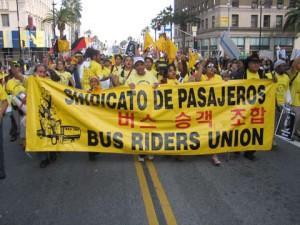
Looking at this from a libertarian socialist point of view, there are both things to learn from and to criticize. Criticizing the Strategy Center’s vanguardism shouldn’t blind us to the fact that they’ve built a mass organization, have an educational program for training organizers, and have made significant gains. If libertarian socialists prefer a different approach, the challenge for us is to prove this will work in practice.
Tactics
The Strategy Center/BRU select only certain priority bus routes to organize on. This includes the two busiest routes, on Vermont Avenue and Wilshire Boulevard. With office buildings splayed out near Wilshire from downtown to the ocean, this has become the city’s main drag and the Wilshire bus service has the highest volume of any bus line in L.A. When the organizers get on the bus, they tell the driver they’re organizing with the BRU and distribute leaflets.
The Vermont and Wilshire lines bisect densely populated, multi-ethnic west-central Los Angeles. This is an area of mostly working class neighborhoods south of the wealthy Hollywood Hills and lying between the downtown and the predominantly white, middle class Westside. This area is the heart of the L.A. transit system.
BRU also does organizing on the Soto Street crosstown bus that runs through the densely populated and heavily Latino Boyle Heights neighborhood east of downtown. Also, their organizers can be seen on the Crenshaw route — a line that passes the Baldwin Hills Mall and Leimert Park Village in the heart of L.A.’s African-American community. The particular mix of routes ensures regular contact with the various ethnic or racial groups that make up the city’s working class population.
The BRU has tried to reach out to the drivers. BRU supported the 2000 drivers’ strike. When I interviewed drivers in a rank-and-file union opposition group, they told me: “The Bus Riders Union wants the same things we do.”(4) But the corrupt and undemocratic bureaucracy of the union (United Transportation Union) has shown no interest in reaching out to the BRU.
The Strategy Center has used the slogan “Fight Transit Racism” to frame the BRU organizing. In part, this refers to the structural racism that was exhibited by the MTA in the late ’80s/early ’90s decisions that degraded service for working class people of color who ride the buses. Also, the Strategy Center decided on a tactic of trying to block the 1993 fare hike by arguing in federal court that it was a violation of the 1964 Civil Rights Act.
The lawsuit was never decided on its merits. The MTA was in such broad discredit that Republican Mayor Richard Riordan capitulated — agreeing to a 10-year collective bargaining arrangement in the form of a judicial Consent Decree.
The Strategy Center has argued that greater subsidies are provided to rail lines that serve a more predominantly white, affluent ridership. This argument has some plausibility when directed against the Metrolink suburban diesel railway. This suburban network was set up in the early ’90s with hundreds of million of dollars in county transit sales tax funds. It links far-flung ex-urban regions into L.A.’s downtown. A study in the ’90s showed that 63 percent of Metrolink riders work as managers and professionals. The average household income of Metrolink passengers was 81 percent higher than the Los Angeles County median household income. Also, two thirds of the riders were white.(4)
Suburban commuter railways in the USA typically have a whiter and more affluent ridership than city public transit systems. For example, the Metro-North and Long Island commuter railways in New York have a ridership that is 79 percent white whereas New York City subway riders are 49 percent white. Median income of bus and subway riders in New York City is 10 percent below the city median income. For Metro-North, 42 percent of the riders have incomes over $100,000.(5)
Because Metrolink is not operated by MTA, the Strategy Center/BRU have directed their attack against the MTA’s urban rail lines.
I don’t believe the Strategy Center has a plausible case here. In 1998 the MTA did a demographic survey of its ridership:
Subway Riders MTA Bus Riders Blue Line Riders Green Line Riders L.A. County Population
White non-Latino 25 percent 13 percent 11 percent 14 percent 29 percent
Family incomes
under $15,000 33 percent 69 percent 52 percent 40 percent 13.7 percent
under $50,000 81.6 percent 96 percent 88.5 percent 80 percent 47 percent
No vehicle available 62 percent 80 percent 68 percent 65 percent 30 percent
The Blue and Green Line and subway ridership comes overwhelming from working class communities of color. These lines seem to attract more working class people with somewhat higher incomes and more people who have cars. In fact, any faster, higher quality transit service is likely to have this effect.
In recent years Mayor Antonio Villaraigosa has been pushing to extend the Wilshire Boulevard subway at least to Westwood Village. To finance bus and rail rapid transit projects, the MTA put a half-cent sales tax on the ballot in November, 2008. Although the Strategy Center/BRU opposed this, it passed with 74 percent of the vote.
The Strategy Center has been pushing surface bus lanes as an alternative to the Wilshire subway. End-to-end speed would be 16 miles per hour versus 32 miles per hour for the subway. To evaluate these alternatives we need to look at the concept of traffic density on a transit facility.
We can think of each mile you’re on the bus or train as a unit of consumer benefit. The farther you go, the more benefit you’re getting…and the more resources you’re using. The more passenger miles a line squeezes into each mile of the route, the greater the flow. Thus we can measure the density of the traffic flow by looking at the number of passenger miles a transit route or system serves up per route mile per year.
We can see the difference rail rapid transit makes by comparing density on a number of Los Angeles services:
Route Traffic Density
(passenger miles per route mile) Average Ride Length
(in miles)
L.A. subway 13.8 million (2008) 5
Blue Line 7.9 million 7.1
All MTA light rail lines 5.6 million (2008) 7.1
Orange Line busway 3 million (2007) 5.9
Vermont Avenue bus line 2.53 million (1997) 2.2
Wilshire Blvd bus line 2.64 million (1997) 4.2
Normandie Ave bus line 748,000 (1997) 2.4
Wilshire Blvd/Whittier Blvd Rapid bus 2.38 million (2001) 5.9
The traffic density on the L.A. subway is higher than the Chicago or Philadelphia rapid transit systems but lower than DC Metro or the Boston Red and Orange lines.
The proposed subway out Wilshire is likely to have at least the traffic density of the existing subway. But the Rapid bus on Wilshire has only one-fifth of the subway’s traffic flow. Even with improved bus lanes, it can’t match the subway’s potential. Although there is a case for rapid transit, the BRU is needed to ensure that this isn’t built by looting the existing service or slashing the social wage.
Victories
The Bus Riders Union has achieved a number of victories. After MTA agreed to the collective bargaining arrangement in 1995, the BRU was able to retain the discount monthly pass and add a new weekly pass. The Consent Decree enabled the Strategy Center/BRU to prevent a fare hike for 12 years. The BRU estimates the total benefit to the riders from its efforts during this period at $2.5 billion.
The Strategy Center also pressured the MTA into replacing its aging diesel bus fleet with 1800 natural gas buses. These buses emit less particulate pollution than the old diesels but it’s an exaggeration to say gas is a “clean” fuel. A gas field can emit as much toxic pollution as one of Houston’s oil refineries. In the early ’90s there had been a campaign to install electric buses in Los Angeles, but the Strategy Center failed to support that proposal.
Under the slogan “No Seat No Fare,” the BRU carried out a fare strike on Thursdays against overcrowding in 1999. Groups would get on a bus and announce to the driver they were not paying. Ultimately the BRU was successful in getting the MTA to expand the bus fleet by 550 buses. 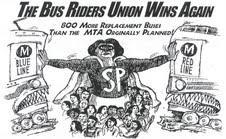
Responding to pressure from the BRU, the MTA introduced a new type of express bus service — Rapid buses. These are buses that provide a faster trip because their stops are spaced a mile apart. The initial test was the Wilshire Rapid, introduced in 2000. This led to a 42 percent increase in rides on Wilshire Boulevard…and attracted car-owners and probably more white folks as well.
In the current environment of attacks on the public sector and the social wage, the Los Angeles MTA is proposing a 20 percent across the board fare hike and a reduction of 388,000 hours of bus service. For eight days in May BRU members conducted a hunger strike in a tent next to the old Plaza Church — a short distance from the Taj Mahal. At the MTA Board meeting on May 27th, the Board chair refused to start with a public hearing on the proposed fare hikes. The BRU had been organizing for days to get people to a hearing at this meeting. So, 150 BRU members simply blocked the meeting from continuing and some members were arrested.(7)
Rider Organizing in San Francisco
The visibility and successes of the Los Angeles BRU spurred transit rider organizing in a number of other cities — Vancouver, Boston, Atlanta, San Francisco, and elsewhere.
Between 2003 and 2009, the city-owned Muni in San Francisco raised the fare three times, from $1 to $2. And this year the agency enacted a 10 percent cut in service. In 2003 and 2005 there were failed attempts to fight fare hikes with a fare strike.(8)
The organizing in 2005 began with lobbying by various non-profits organized in a Transit Justice Coalition. But Muni management simply rolled over this opposition with a decision in March for a fare hike in September. This meant organizers had six months to prepare for a fare strike. Organizing was initiated by a group of anarcho-communists associated with the Bay Area Anarchist Council. They envisioned a joint worker/rider action such as the actions initiated by transit workers in Nantes, France and Turin, Italy in the late ’70s. In those actions, transit workers continued to run the buses but refused to collect fares. In the early ’80s Adam Cornford coined the term “social strike” for this type of action. Thus the anarchists decided on the name “Social Strike” for their group. Since “social strike” is not exactly in everyday use, this is a rather arcane name to most people. Kevin Keating, one of the initiators of this group, had suggested the grittier name “Refuse to Pay.”
At the first meeting, the Transit Justice Coalition sent a leftist nonprofit staffer as a liaison. But Keating’s constant patter of insults directed at her seemed to cut off that potential source of support. Keating, to his credit, did encourage the people in Social Strike to initially focus on outreach to the drivers. Leaflets were distributed to drivers on the main routes, and contacts were made with the Drivers Action Committee — a rank and file opposition in the drivers union,
Transport Workers Union Local 250A.
Social Strike also began by organizing two “town hall” meetings. But these were poorly advertised and poorly attended. Several of the attendees — Marc Norton (a veteran of the ’80s Maoist group Line of March) and members of a loose council communist grouping, Insane Dialectical Posse, then initiated a separate group, Muni Fare Strike. The Fare Strike group focused on passing out leaflets to riders.
To its credit, however, the Fare Strike group did do outreach to gain support among a variety of community organizations — a Latina women’s collective, Green Party people, the Chinese Progressive Association, and the day laborers’ organization. Speakers from these various groups were present at two public speakouts that were held on the busy Mission Street bus route.
After several months of organizing, a Transit Justice Coalition meeting was called where people from Social Strike and Fare Strike groups tried to gain the Coalition’s endorsement of the fare strike. The main group in the Transit Justice Coalition was a large hierarchical non-profit, Tenderloin Neighborhood Housing Clinic. The TNHC staffers blocked the endorsement.
A total of about 50 activists were involved in the fare strike organizing. The addition of the day laborers’ organization was the most important extension. This group did outreach to Spanish-speaking immigrants. On the day of the fare strike, they ushered groups of riders onto buses along Mission Street. They also gained the support of Latino bus drivers, who refused to collect fares.
Many of the anarchists in Social Strike flaked after a couple months. By the time the September fare hike rolled around, only about five members of that group were still involved. On the day of the actual fare strike, the Fare Strike group deployed its people at several major stops on the busiest route — Mission-Van Ness. But the city was prepared. Squads of motorcycle cops throughout the day moved in on any concentration of fare strike protestors.
About two thousand people participated in the fare strike on the first day. But the action was not big enough to make a dent in Muni’s revenue. Muni bureaucrats simply rolled on with their plan.
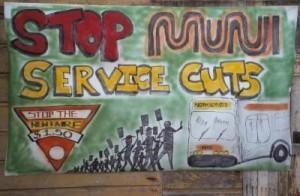
I had proposed a project of creating an on-going Muni riders’ union. If the groups were to do regular tabling at busy bus stops, with colorful banners and handing out literature, they could sign up people as members in a mass organization. They could invite these people to subsequent meetings to talk about actions and get more people involved in the organizing on the ground. Of course, these meetings would need to be conducted in a way that would be comfortable to people who might not be in 100 percent agreement with the most ultra-anti-capitalist rhetoric.
Anarcho-communists and council communists told me an ongoing riders’ union would be “reformist”. They predicted it would be bogged down in supporting candidates for election and lobbying.
The Social Strike and Fare Strike groups were focused on a protest “action” — they failed to view this as just one battle in a longer war. If a militant minority rider organization had been created, it could continue the battle through other tactics — ongoing fare resistance (such as encouraging people to get on through the back doors), speaking out or jamming public hearings, and general educational work among the riding public. They could build momentum to go after the big downtown banks and building owners to pay for Muni. A role for libertarian socialists in such a group would be to argue for a militant course and against becoming a hierarchical non-profit or an appendage of the Democratic Party. The Los Angeles BRU has remained a militant voice for 17 years. If libertarian socialists believe in our own ideas, we should believe that it would be possible to do this in ways consistent with libertarian socialism.
The current struggle on Muni is a part of the larger struggle against attacks on the social wage and public workers in California. The failure of the libertarian left to create an ongoing rider organization during the 2005 struggle ultimately created a vacuum…and now we see Leninists and other advocates of hierarchical approaches filling the void. There are currently two rider unions being organized in San Francisco.
The S.F. Transit Riders Union (http://www.sftru.org/) is being organized as a project of a local nonprofit, Livable City. Dave Snyder, the organizer of the union, tells me that he initially wanted to build a very broad organization that would attract both working class people of color and middle class riders(9). He proceeded to get endorsements from the Green Party, neighborhood groups in the Marina and Telegraph Hill (affluent areas) and from SPUR (an elite-oriented think tank), but also gained the support of the Chinese Progressive Association and S.F. Youth Commission. When he called a meeting of people who’d signed up with the union, he told me he refused to call it a “membership meeting” because almost all of the people who showed up were white. A credible riders’ union in S.F. needs to be a reflection of the multi-racial ridership. 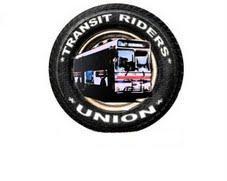
Snyder tells me that the endorsements from the more affluent groups made it impossible for him to get the backing of People Organized to Win Employment Rights (POWER). POWER has organized among workfare workers and in recent years have been fighting gentrification and city redevelopment in Bayview-Hunters Point (the only neighborhood in the city with a large African-American population).
The other rider organizing effort is Muni Operators and Riders for Expanding Transit (http://morepublictransit.net). This is a coalition in which ANSWER (a front for the Party for Socialism and Liberation) and POWER are the main-movers. But there are others involved, including the day laborers’ organization, Chinese Progressive Association, and the drivers’ union, TWU 250A.
MORE Transit has focused on developing a rider-driver alliance but by working with the TWU union leadership. The top manager of Muni makes over $300,000 a year, and the Muni drivers have demanded that any cuts start by shrinking the bloated managerial bureaucracy.
The coalition is also opposing the current practice of Muni “reimbursing” the police department millions of dollars each year. It’s another example of how transit is often used as a cash cow.
MORE Transit has mobilized people to speak out in public hearings and organized a march to defend the drivers against demands for concessions.
MORE Transit has also been fighting Muni’s “saturation raids.” For quite some time there has been pressure in the corporate media to “crack down on fare cheats”. This has led to SWAT-style raids on buses, where police demand that people come up with proof of having paid a fare. From a financial point of view, it’s useless. But it diverts attention away from the local sources of wealth that could be taxed and scapegoats the poor (often people of color) for Muni’s problems. Also, about a dozen immigrants have been deported as a result of the raids.
A number of transit advocacy groups, including both S.F. Transit Riders Union, MORE Transit and the Strategy Center are currently pushing for the U.S. Congress to pass a $2 billion emergency measure to fund existing transit services. If this were passed, it would allow Muni to restore the services that were recently cut.
The struggles of riders are a form of class struggle at the point of consumption. And the struggle to defend and to expand public transit is also an environmental struggle as well. From this brief review, I think we can see that there is a potential for an activist group to create a militant riders organization in a period when cuts and fare hikes are generating anger and a willingness to speak out in opposition. Transit workers themselves are in a potentially strong position to take action, and a rank-and-file solidarity movement among workers could seek to build an alliance with the riders.
Tom Wetzel is a member of Workers Solidarity Alliance.
Notes (1) This data is from the National Transit Database, run by the Federal Transit Administration. The FTA requires all transit agencies in the USA to provide annual reports. To find these reports online, go to http://www.ntdprogram.gov/ntdprogram/links.htm
(2) Interview with Nick Patsaouris, April 22, 1999. Patsouris is a Greek immigrant who is himself a building contractor.
(3) Eric Mann, “A Race Struggle, a Class Struggle, a Women’s Struggle All at Once: Organizing on the Buses of L.A.”, Socialist Register 2001 (http://www.thestrategycenter.org/AhoraNow/body_socialistregister.html) (accessed May 8th, 2002).
(4) Tom Wetzel, “Opposition in Los Angeles Transit Union”, Workers Solidarity #3 (http://www.uncanny.net/~wetzel/LAtransitunionopposition.htm)
(5) “Metrolink Wins Round of Praise from Its Riders”, Los Angeles Times, 5/15/93.
(6) Sources on New York transit demographics:
http://www.gathamgazette.com/article/demographics/20060306/5/1780
“Worried by Ridership Figures, Metro-North is Trying Harder”, New York Times 8/1/2008
(7) http://www.thestrategycenter.org/blog/2010/05/28/hunger-fast-showdown-mt… (8) Participants in the 2005 fare strike effort wrote a number of accounts:
Insane Dialectical Posse, Fare Strike! (http://farestrike.org/).
Kevin Keating, “Muni Social Strikeout” (http://infoshop.org/page/Muni-Social-Strikeout).
Tom Wetzel, “Post Mortem on the San Francisco Fare Strike” (http://workersolidarity.org/archive/WS3farestrike.htm).
(9) Alex Wolens, “Push to Organize SF Transit Riders Proving Difficult”, SF Weekly (http://blogs.sfweekly.com/thesnitch/2010/06/push_to_organize_sf_transit_…)

